Choosing the right web scraping method
Web scraping has come a long way, but when you’re dealing with websites that load content using JavaScript, things can get tricky. If you’ve worked on these types of projects, you know there are a few approaches, but how do you decide which one is best for your needs, especially when scaling up?
Let’s walk through the most popular methods for extracting data from JavaScript-heavy websites and discuss the pros and cons of each.
Replicating JavaScript requests: The old-school approach
This method is all about reverse-engineering the requests that a website makes behind the scenes. In a way, it’s like you’re tricking the website into handing over its data without having to load the whole page. Sounds cool, right?
Well, yes and no. The problem here is that websites change a lot. So every time a site updates its JavaScript, you have to go back and figure out how to tweak your scraper. It’s a constant game of catch-up, which can quickly become a headache, especially if you’re managing multiple projects.
Browser automation tools: Playwright, Puppeteer, and Selenium
If reverse-engineering JavaScript feels like too much of a hassle, you might have turned to browser automation tools like Playwright, Puppeteer, or Selenium. These tools let you control a browser programmatically, allowing you to scrape data from fully rendered web pages, much like a real user would.
Browser automation works well, but it’s not without its downsides. Running several browser instances at once can be resource-heavy and can slow everything down. And let’s not even talk about scalability. The more you scale, the more infrastructure you need—and that can get expensive and complicated fast. Before you know it, you’re juggling multiple systems just to keep things running smoothly.
Network captures: The best of both worlds?
Another option to consider is network captures. It’s a hybrid approach where you use browser automation but focus on capturing the network traffic, like API calls, rather than scraping the page content itself.
This method strikes a balance. You’re still using browser automation but without the overhead of dealing with page rendering. Instead, you’re capturing the data directly through API calls. It’s a smart way to dodge the complexities of reverse-engineering while still getting the data you need. But keep in mind, it’s not without its maintenance challenges.
Integrated Scraping APIs: The smarter, scalable solution
Now, if you’re looking to scale your web scraping operations without all the hassle, the integrated scraping API approach is where things get interesting. Tools like Zyte API simplify everything. Instead of piecing together multiple tools for scraping, proxies, headless browsers, and unblockers, you can use a single API that handles it all.
With Zyte API, for example, you just set one parameter, browser HTML set to true, and it takes care of everything from rendering the page to dodging anti-bot systems. You get the data you need, without the endless monitoring and maintenance tasks. It’s cost-effective, scalable, and most importantly, easy to use.
Why go the API route?
Here’s the thing, when you’re managing large-scale web scraping, you want something reliable and easy to scale. You don’t want to waste time constantly fixing scrapers every time a website changes. With a tool like Zyte API, you can focus on the data and leave the technical headaches behind. Plus, it’s backed by a team of experts, so you have peace of mind knowing that your scraping tasks are in good hands.
Whether you’re new to web scraping or a seasoned pro, picking the right method makes all the difference.
